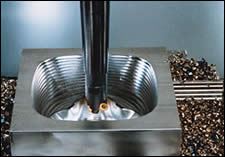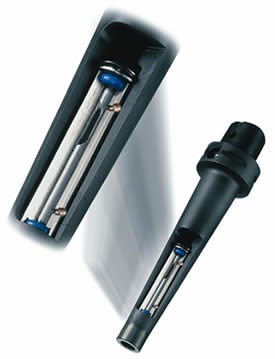Milling Adaptor: Reach Without Reluctance
An alternative to conventional extended-reach toolholders, milling adaptors contain a custom damping mechanism to minimize vibration when milling long overhangs.
Machining deep pockets or cavities requires holding the tool at a large length-to-diameter (L/D) ratio or overhang. In the mold and die sector, shops may need to extend the tool as far out as 2 or 3 feet. The farther the tool extends from the spindle, the more sensitive the application becomes toward vibration.
Most shops respond with delicacy. Process parameters may be adjusted to compensate for the diminished stability. At long overhangs, shops reduce the speeds, feed rates and depths of cut. However, this causes productivity levels to dip. A more appealing option is to employ tooling that is able to calm the chatter.
Sandvik Coromant Co. (Fair Lawn, New Jersey) offers an alternative to conventional extended-reach toolholders: a “Silent Tools” milling adapter that features characteristics for minimizing vibration. According to the manufacturer, the custom damping mechanism encased in the adapter body can quiet virtually any perceptible chatter while end milling or profile milling with overhangs as long as seven times the diameter. Jim Grimes, a technical specialist at Sandvik Coromant, explains that reducing vibration doesn’t have to translate to slower speeds and feeds or lighter depths of cut.
The adapter connects to a machining center toolholder via a Sandvik Coromant Capto coupling. A single toolholder can therefore use different lengths of adapters.
Within the adapter, the tuning body (see illustration) effectively absorbs the chatter that is triggered during milling. This mass is suspended inside the bar with two rubber bushings—one at each end. Oil surrounds the tuning body. If harmonic oscillation tendencies arise during machining, the tuning system springs into action (so to speak). The kinetic energy of the vibration is counteracted by the movement of the tuning body against the rubber bushings in the oil. In this way, the vibration is damped and quieted.
“Any radial movement of the tool can generate vibration,” says Mr. Grimes. “To counteract this, the body inside the shank moves in the opposite direction of the cutting edge because of the way it is suspended in the fluid.”
Proven in mold and die applications, the damped milling adapters have also been implemented by companies in the aerospace sector to avoid problems associated with chatter. In applications such as these, Mr. Grimes says the ROI comes from productivity because shops can successfully mill at challenging overhangs to achieve faster material removal rates.
Related Content
-
A New Milling 101: Milling Forces and Formulas
The forces involved in the milling process can be quantified, thus allowing mathematical tools to predict and control these forces. Formulas for calculating these forces accurately make it possible to optimize the quality of milling operations.
-
Best Practices: Machining Difficult Materials
Cutting hardened steel, titanium and other difficult materials requires picking the right tools, eliminating spindle runout and relying on best practices to achieve tight part tolerances.
-
Five-Axis Changes Weldments Into Monolithic One-Piece Parts
Moving from welding to five-axis machining enabled Barbco to redesign its weldments as monolithic one-piece parts with improved strength and repeatability.
















.png;maxWidth=300;quality=90)
